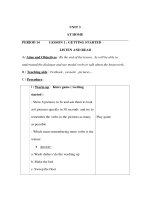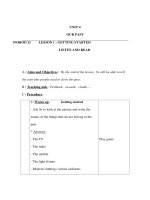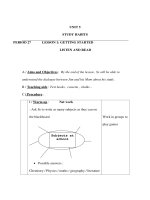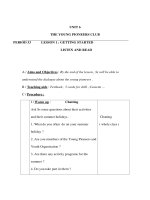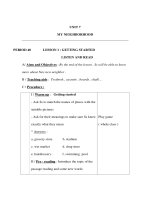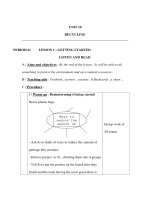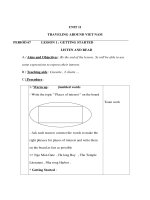Giáo án Anh văn lớp 9 - Unit 2 Clothing - Period 7 - Lesson 1 : Getting started Listen and read potx
Bạn đang xem bản rút gọn của tài liệu. Xem và tải ngay bản đầy đủ của tài liệu tại đây (90.94 KB, 5 trang )
Unit 2
Clothing
WEEK 4 Lesson 1 : Getting started
Period 7 Listen and read
Ngµy so¹n :
Ngµy d¹y :
A / Aims and Objectives : By the end of the lesson , Ss will be able to know
something about traditional dress and the Ao dai .
+ Vocabulary : traditional dress , long silk tunic , material , fashion and
designer
+ Skills : Reading and answering the questions .
B / Teaching aids : Textbooks , cassette , chalk , boards and some pictures …
C / Procedure :
7 min
I / Warm up : Crossword
1. The country whose capital city is Phnom Penh
2. A friend who keeps contact through letters
3. The place we go to study .
4. The country has the beautiful beaches of Phu ket and
Pattaya.
5. The country has the largest population in the world .
6. The country is the smallest among ASEAN members
.
7. The money system is used in a country .
8. It is the belief in superhuman especially in Gods
- Remark and lead in the new lesson.
=> Key word : Clothing
II / Presentation :
1. Pre – reading : Introduce “ Today we will learn
aboutthe traditional costumes of some countries . First ,
you look at the address that some people are wearing
Decide where each person comes from :
- Call on some Ss to demonstrate their ideas in front of
class.
- Correct and give the right answers :
+ She comes from Japan . She is wearing a Kimono .
+ She comes from Viet Nam . She is wearing an Ao dai
+ He comes from Scotland . He is wearing a kilt .
+ She comes from India . She is wearing a Sari .
Play games
- Repeat all the
words in chorus and
individually .
- Listen carefully
- Demonstrate their
ideas in front of
class.
15 min
+ He comes from the USA . He is wearing a Cowboy .
+ She comes from Arabia .She is wearing a Veil.
- Explain some costumes to students .
- Eliciting about Ao dai of Viet nam and ask some
questions :
1. What do you know about Ao dai ?
2. What material is Ao dai often made from ?
3. Who wears the Ao dai ?
4. Is modern Ao dai different from the old one ? …….
- Remark and explain some new words :
+ Poet (n)
Ex : To Huu is a great poet .
+ Musician (n)
Ex : Trinh Cong Son is a great Musician .
+ Long silk tunic (n) : Translation
+ Loose pant ( n) Translation
+ Ethnic minorities (n) Explanation
+ Traditional designs (n)
+ Fashionable (a) Translation
Checking technique : What and where
2. While reading :
- Listen and copy
down .
- Practice answering
the questions .
- Listen and repeat in
chorus and
individually .
- Guess its meanings
and give examples .
- Write down
- Play games
- Listen and
15 min
- Now look at “ Listen and Read “ and turn on the tape .
Then complete the sentences , using the information from
the passage .
- Call on some Ss to read their answers aloud
- Correct and give the correct answers :
1. …poems , novels and songs .
2 long silk tunic with slits up the sides worn over loose
pants .
3. To wear modern clothing at work .
4. ….lines of poetry on it .
5. Symbols such as suns , stars , crosses and stripes
- Ask them to read the text aloud in front of class.
- Have Ss read the text again and answer the questions in b
- Ask them to exchange their results and compare with a
friend .
- Call on some pairs to practice asking and answering .
- Listen and correct mistakes if any .
- Give correct answers :
complete the
sentences .
- Read the complete
sentences loudly .
- Copy down
- Read the text
loudly
- Read the text and
answer the questions
in pairs .
- Practice in the front
.
6 min
2 min
1. Traditionally , men and women used to wear the Ao dai .
2. Because it is more convenient .
3. They have printed lines on poetry on it or have added
symbols such as suns , stars , crosses , and stripes to the Ao
dai .
3 . Post –reading :
- Get Ss to work in pairs to ask and answer the questions
about the Ao dai .
- What color is popular with Ao dai ?/ with students at high
school ? / with the middle – aged …?
- Go around and help them if necessary .
- Call on some pairs to practice in font of class.
- Remark and correct mistakes .
III / Homework :
1. Learn by heart new words and make some examples
with each one .
2. Redo the exercises and copy down .
3. Prepare the next lesson .
- Write down
- Work in pairs
- Practice in the front
.
- Listen and copy
down .
